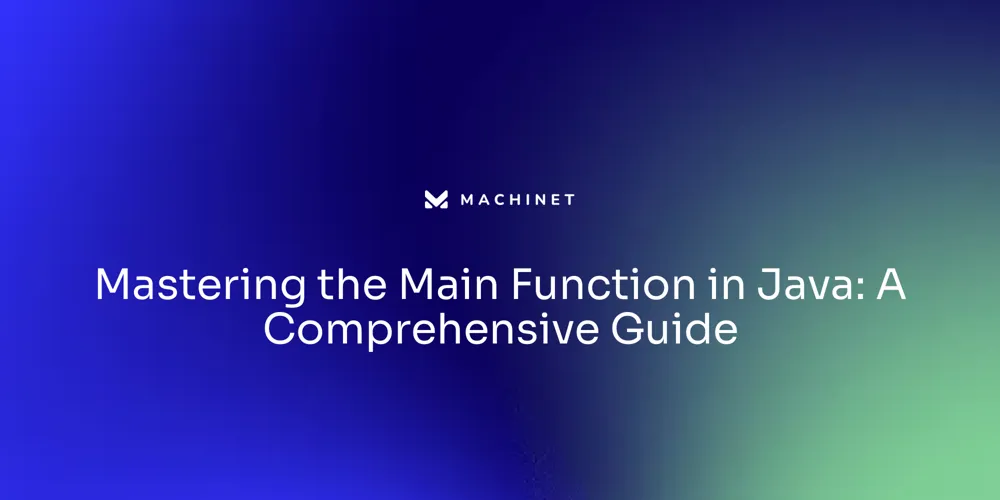
Table of Contents
- For Loop in Java
- While Loop in Java
- Do-While Loop in Java
Introduction
The article introduces the three fundamental loop constructs in Java: the for loop, the while loop, and the do-while loop. Each loop has its unique structure and purpose, allowing developers to control the flow of code execution based on specific conditions.
The article explores the syntax and functionality of each loop, highlighting their use cases and potential pitfalls. It emphasizes the importance of understanding and utilizing these loops for efficient programming and problem-solving in Java. Despite the evolving nature of the language, the article asserts that these loop constructs remain integral to Java's enduring relevance in software development.
For Loop in Java
In Java, the for loop is a fundamental control flow mechanism that empowers developers to execute a block of code multiple times, with precise control over each iteration. The structure of a Java for loop consists of three parts: initialization, condition, and update. Here's the anatomy of the syntax:
java
for (initialization; condition; update) {
// code to be executed
}
The loop kicks off with the initialization phase, which sets up the loop control variable and is executed just once.
Next, the condition is assessed before every iteration, dictating whether the loop should continue. If the condition is true, the loop's body is executed. After each iteration, the update expression modifies the loop variable, preparing it for the next round.
Take, for instance, a simple for loop that prints out iteration numbers:
java
for (int i = 0; i < 5; i++) {
System.out.println("Iteration: " + i);
}
This loop will run five times, with the output indicating each iteration, from 0 to 4. It's a clear-cut example of how a for loop operates, but developers must remain vigilant of common pitfalls like the off-by-one error, where incorrect condition logic can lead to unexpected iterations. Java's for loop is not only about simple iterations.
It demonstrates the language's commitment to clean, organized code that adheres to the Single Responsibility Principle. Each loop encapsulates a specific task, making the code more maintainable and easier to understand. Additionally, Java's libraries offer optimized loop constructs, like IntStream and LongStream, providing alternatives to the traditional for loop for more complex scenarios.
Even as Java evolves, with JDK 23 introducing new features like the Vector API, the for loop remains a staple in Java's vast ecosystem. Its utility is timeless, from solving mathematical puzzles like the "Happy Number" problem to streamlining operations with efficient looping constructs in frameworks like Spring. Java's for loop is a testament to the language's enduring relevance in software development.
While Loop in Java
In the world of Java programming, control flow statements like the while loop play a crucial role in managing the execution of code. The while loop, in particular, is essential when the number of iterations cannot be determined beforehand.
It operates under a simple premise: execute the block of code inside the loop as long as the specified condition remains true. Here's the basic structure of a while loop in Java:
java
while (condition) {
// code to be executed
}
Before every iteration, the loop evaluates the condition.
If the result is true, the loop's body runs. However, if the condition is false at the outset, the code inside the loop is bypassed entirely.
For instance, consider this snippet of code:
java
int i = 0;
while (i < 5) {
System.out.println("Iteration: " + i);
i++;
}
In this example, the loop will execute five times, outputting the iteration number each time. Such loops are not just theoretical constructs; they have real-world applications, like in algorithm design and testing scenarios such as the 'Happy Number' problem that has both intrigued and challenged developers. As Java continues to be a strong force in software development, understanding and utilizing loops such as the while loop is vital for efficient programming and tackling complex problems. Moreover, being mindful of common errors, like the off-by-one error, can prevent unnecessary debugging and ensure that the loops perform as intended, enhancing the reliability and readability of the code.
Do-While Loop in Java
Java's do-while loop stands out for ensuring the loop's body is executed at least once, even if the loop's condition is initially false. This structure is essential when the operation within the loop must occur before the condition is tested, such as in user input scenarios or certain algorithm implementations.
Here's the syntax for a do-while loop:
code:
java
do {
// code block to be executed
} while (condition);
First, the code block within the do section is performed. Subsequently, the condition is assessed.
If true, the loop reiterates. To illustrate, consider the following example where the loop will print the iteration number five times, starting from zero:
code:
java
int i = 0;
do {
System.out.println("Iteration: " + i);
i++;
} while (i < 5);
This loop's output demonstrates the off-by-one error avoidance, ensuring the loop executes the precise number of times as intended. Java's steadfast presence in the programming world since 1995, as evidenced by its third-place ranking in popularity among programming languages, shows the importance of understanding such fundamental constructs. Especially with the introduction of JDK 23's new features, Java continues to evolve while maintaining its core functionalities that have been critical to its long-standing success in various applications, from web development to mobile apps.

Conclusion
In conclusion, the article explores the three fundamental loop constructs in Java: the for loop, the while loop, and the do-while loop. Each loop has its unique structure and purpose, allowing developers to control the flow of code execution based on specific conditions.
The for loop provides precise control over each iteration with its initialization, condition, and update phases. It is a versatile construct that can handle simple iterations as well as complex scenarios using optimized loop constructs like IntStream and LongStream.
The while loop is essential when the number of iterations cannot be determined beforehand. It executes the block of code inside the loop as long as the specified condition remains true.
Understanding and utilizing this loop is crucial for efficient programming and tackling complex problems. Java's do-while loop ensures that the loop's body is executed at least once, even if the initial condition is false.
It is particularly useful in scenarios where operations within the loop must occur before testing the condition. Despite Java's evolving nature, these loop constructs remain integral to its enduring relevance in software development. They provide clean and organized code, adhere to principles like Single Responsibility, and offer solutions to various problem-solving scenarios. Developers must be aware of common pitfalls like off-by-one errors and leverage these loops effectively to enhance code reliability and readability. Overall, understanding and utilizing these fundamental loops are vital for efficient programming and problem-solving in Java. They contribute to Java's long-standing success in various applications and demonstrate its commitment to evolving while maintaining core functionalities.
Master the power of Java loops and level up your programming skills today!
AI agent for developers
Boost your productivity with Mate. Easily connect your project, generate code, and debug smarter - all powered by AI.
Do you want to solve problems like this faster? Download Mate for free now.




